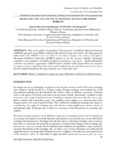| dc.contributor.author | Ntawihebasenga, Jean de Dieu | |
| dc.contributor.author | Mwita, Peter N. | |
| dc.contributor.author | Mung’atu, J.K. | |
| dc.date.accessioned | 2018-11-16T09:06:50Z | |
| dc.date.available | 2018-11-16T09:06:50Z | |
| dc.date.issued | 2014-12 | |
| dc.identifier.issn | 2055-0162 | |
| dc.identifier.uri | http://ir.mksu.ac.ke/handle/123456780/1650 | |
| dc.description.abstract | This work applied Generalized Autoregressive Conditional Heteroskedasticity
(GARCH) approach to modelling volatility in Rwanda Exchange rate returns. The Autoregressive
(AR) model with GARCH errors was fitted to the daily exchange rate returns using Quasi-
Maximum Likelihood Estimation (Q-MLE) method to get the current volatility. Asymptotic
consistency and asymptotic normality of estimated parameters were given. Akaike Information
criterion was used for appropriate GARCH model selection while Jarque Bera test used for
normality testing revealed that both returns and residuals have fat tails behaviour. It was shown
that the estimated model fits Rwanda exchange rate returns data well.
KEYWORDS: Model, Volatility, Exchange rate, Quasi Maximum Likelihood, GARCH model. | en_US |
| dc.language.iso | en_US | en_US |
| dc.publisher | European Centre for Research Training and Development UK | en_US |
| dc.subject | Model | en_US |
| dc.subject | Volatility | en_US |
| dc.subject | Exchange rate | en_US |
| dc.subject | Quasi Maximum Likelihood | en_US |
| dc.subject | GARCH model | en_US |
| dc.title | MODELLING THE VOLATILITY OF EXCHANGE RATES IN RWANDESE MARKETS | en_US |
| dc.type | Article | en_US |

